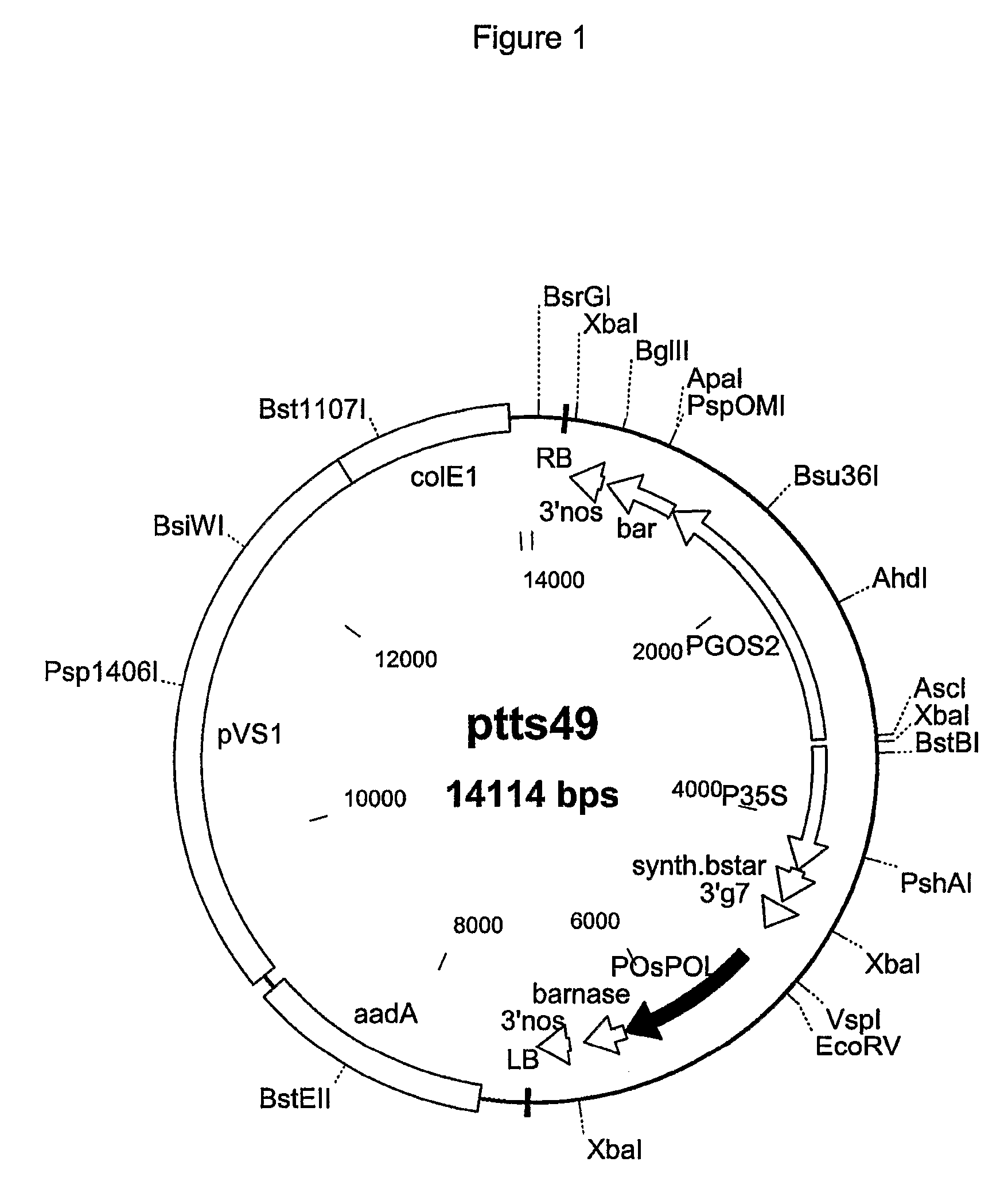Rice pollen-preferential promoters and uses thereof
- Summary
- Abstract
- Description
- Claims
- Application Information
AI Technical Summary
Benefits of technology
Problems solved by technology
Method used
Image
Examples
example 1
Identification and Characterization of a Pollen-Preferential cDNA Sequence from Rice
[0170]A pollen-specific gene from Nicotiana tabacum, designated as NTP303, has been isolated and characterized (Weterings et al. and Hulzink et al., supra). The protein sequence of NTP303 (accession number P29162) was used as a query in a BLAST search restricted to Oryza sativa and a BAC end sequence (accession number AQ577962) was identified. The BLAST results showed that translated nucleotides 116 to 367 of AQ577962 (593 nucleotides in length) show 57% sequence identity and 75% sequence conservation with amino acids 207 to 290 of P29162 (554 amino acids in length). AQ577962 is derived from leaf tissue of Oryza sativa japonica Nipponbare. It has not been described that AQ577962 encodes a rice pollen-preferential gene.
[0171]AQ577962 was used as a query in a BLAST search restricted to expressed sequence tags (EST) from Oryza sativa and identified two rice cDNA sequences (accession numbers BE041024 and...
example 2
Identification and Characterization of Pollen-Preferential Genes from Oryza Sativa Japonica and Indica Corresponding to the Rice Pollen-Preferential cDNA Sequence of Example 1
[0200]Using C72996 as a query in a BLAST search, an Oryza sativa japonica chromosome 5 clone has been identified (accession number AC093952). Nucleotides 20873 to 20458 of AC093952 (127642 nucleotides in length; nucleotides 2128 to 2543 of SEQ ID No 4) show 97% sequence identity with nucleotides 1 to 420 of C72996. Furthermore, translated nucleotides 21527 to 20205 of AC093952 (nucleotides 1474 to 2796 of SEQ ID No 4) show 59% sequence identity and 73% sequence conservation with amino acids 11 to 454 of P29162. It has not been described that AC093952 encodes a rice pollen-preferential gene.
[0201]SEQ ID No 4 (AC093952 from nucleotide 23000 to 19001) was used as a query in a BLAST search and a putative rice coding sequence (TIGR model temp id(s): 8353.m 03630; SEQ ID No 8) was identified (the encoded protein is r...
example 3
Isolation and Characterization of a Pollen-Preferential Promoter Region (“POsPOL”) Corresponding to the Rice Pollen-Preferential Genes of Example 2
[0220]Primer TSOL109 (SEQ ID No 5) was designed based on the recognition sites of restriction enzymes BgIII and EcoRV and nucleotides 320 to 336 of SEQ ID No 4 (approximately 1110 bp upstream of the putative translation initiation codon). Primer TSOL119 (SEQ ID No 6) was designed based on the recognition sites of restriction enzyme NcoI and nucleotides 1412 to 1430 of SEQ ID No 4 (upstream of the putative translation initiation codon). Primers TSOL 109 and TSOL 119 were used in a polymerase chain reaction (PCR) on genomic DNA of Oryza sativa japonica Lemont.
[0221]Each PCR reaction contained Advantage-GC cDNA Polymerase Mix (BD Biosciences), 10 pmol TSOL109 primer, 10 pmol TSOL 119 primer and 200 ng genomic DNA in a total volume of 50 μl overlaid with mineral oil.
[0222]PCR cycles were as follows:[0223]1 PCR cycle included a denaturation te...
PUM
| Property | Measurement | Unit |
|---|---|---|
| pH | aaaaa | aaaaa |
| volume | aaaaa | aaaaa |
| temperature | aaaaa | aaaaa |
Abstract
Description
Claims
Application Information
 Login to View More
Login to View More - R&D
- Intellectual Property
- Life Sciences
- Materials
- Tech Scout
- Unparalleled Data Quality
- Higher Quality Content
- 60% Fewer Hallucinations
Browse by: Latest US Patents, China's latest patents, Technical Efficacy Thesaurus, Application Domain, Technology Topic, Popular Technical Reports.
© 2025 PatSnap. All rights reserved.Legal|Privacy policy|Modern Slavery Act Transparency Statement|Sitemap|About US| Contact US: help@patsnap.com


